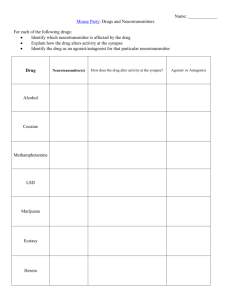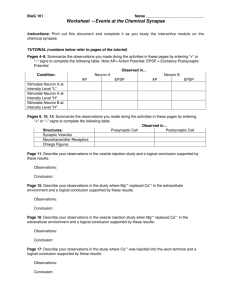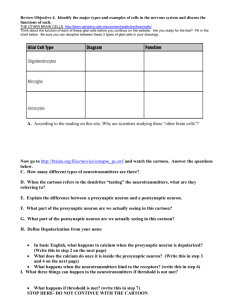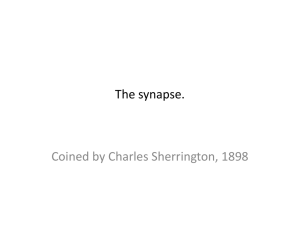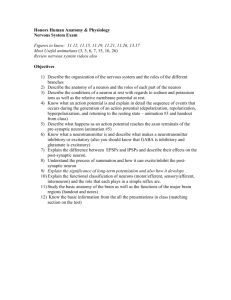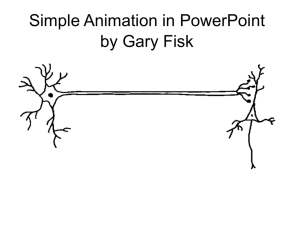Neurophysiology II: The Synapse
advertisement
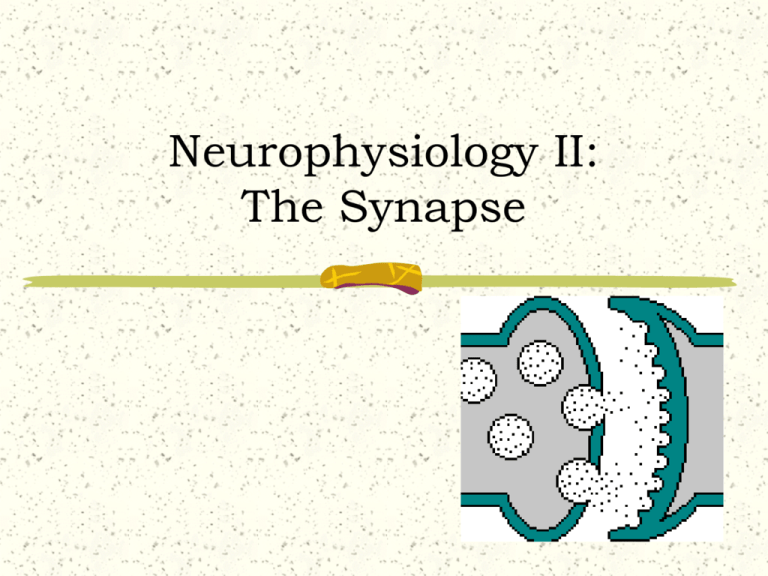
Neurophysiology II: The Synapse Synapse Defined Space between adjacent neurons! Relays information from one neuron to another! Neuron Neuron Neuron Muscle Neuron Gland Axodendritic Synapses Most common synapse type in body How do synapses work? ELECTRICAL SYNAPSES: Allow ion flow from AP to continue from neuron to neuron Transmission of information is extremely rapid! Allow for synchronized neuron activity! Electrical Synapses continued Isolated in the body! CNS: Sleep arousal Concentration Emotion/memory centers Embryonic Nervous Tissue: Predominant synapse type! Will develop into… CHEMICAL SYNAPSES! Release chemicals across synapse from neuron to neuron (or muscle, gland) Chemicals are known as: N E U R O T R A N S M I T T E R S! CHEMICAL SYNAPSES ARE: THE MOST COMMON TYPE OF SNYAPSE IN THE BODY! Composed of Three Major Areas: Axon terminal on Presynaptic Neuron! Synaptic Cleft (the space!) Receptor region on Postsynaptic Neuron! Vesicles of neurotransmitter Axon terminal presynaptic neuron Synaptic cleft postsynaptic neuron Receptors Neuron functioning is… AN ELECTROCHEMICAL EVENT!! The “Electro” Part: Generation of Action Potential along axon AP will “fizzle out” at axon terminal! The “Chemical” Part Neurotransmitters are: 1. Released from presynaptic axon terminal 2. Diffused across synaptic cleft 3. Bound to receptors on postsynaptic cell How the “Chemical” Part Works… The Players: NEUROTRANSMITTER (stored in vesicles) CALCIUM The Steps: 1. AP reaches axon terminal 2. Voltage-gated Calcium Channels open! 3. Ca++ rushes into axon terminal membrane! (will get pumped back out later) 4. Influx of Calcium causes vesicles (containing neurotransmitter) to fuse with axon terminal membrane 5. Exocytosis occurs! 6. Neurotransmitter released into synaptic cleft 7. Neurotransmitter diffuses across synaptic cleft 8. Neurotransmitter binds to receptor proteins on membrane of postsynaptic neuron. 9. Ion channels on postsynaptic membrane open! 10. Membrane permeability changes 11. EPSP (Excitatory Post-Synaptic Potential) or IPSP (Inhibitory PostSynaptic Potential) begins! EPSP vs. IPSP Determined by type of neurotransmitter released EPSP neurotransmitter stimulates the neuron to depolarize at the axon (AP occurs!) (What axon channels will open to do this?) IPSP neurotransmitter inhibits depolarization at the axon (NO AP!) Instead… neurotransmitter causes hyperpolarization at axon! K+ channels open K+ moves out! Cl- channels open Cl- moves in! Now that it’s over… HOW DO YOU STOP THE EFFECTS OF THE NEUROTRANSMITTER? 3 OPTIONS! 1.Neurotransmitter is broken down by enzymes 2. Neurotransmitter is Reabsorbed/recycled by presynaptic cell 3. Neurotransmitter diffuses out of synapse ACh=neurotransmitter E= Enzyme Summary of Neurotransmitters… chemical messengers present in terminal and discharged upon stimulation produce membrane potential changes on postsynaptic cell naturally removed from synapse most cells make and respond to more than one neurotransmitter Over 50 chemicals are known to function as NEUROTRANSMITTERS! BUT 1 chemical is the most well known! ACETYLCHOLINE 1st neurotransmitter idenitified Used at neuromuscular junctions Excitatory to skeletal muscles! (EPSP) Effect : muscle contraction Abbreviated ACh ACh=neurotransmitter E= Enzyme ACETYLCHOLINESTERASE ENZYME USED TO BREAK DOWN ACh bound to post synaptic receptors! Abbreviated AChE NERVE AGENTS Other Neurotransmitters NAME Norepinephrine Dopamine Seratonin Histamine Endorphins GABA EFFECT Feelings of Euphoria Feelings of Euphoria Sleep State Inflammation Pain Inhibitor Major IPSP Effect! Cholinergic synapses Use acetylcholine as NT Parasympathetic Division Adrenergic Synapses Use noradrenaline as NT Sympathetic Division Endorphins vs. Enkephalins “The Pain Killers” Bind to postsynaptic receptors Block calcium channels in presynaptic neuron Parkinsons Disease Causes of Parkinsons Dopamine deficiency! Results in contraction of antagonistic muscles! Results in uncontrolled shaking


